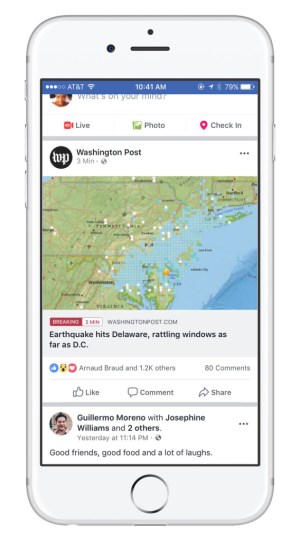By Alex Hardiman, Head of News Products
Update on November 1, 2018 at 1:30 PM PT: Over 250 publishers across the globe now use the breaking news label today, which can be seen by Facebook users in Canada, the US, the UK, Australia, Mexico, Spain, France and Germany.
Originally published on August 7, 2018:
On June 23, 2018, floodwaters suddenly trapped a team of teenage soccer players who’d been exploring a cave complex in Thailand. Over 17 days, the world watched anxiously as rescue teams assembled, divers located the boys, and a two-day operation finally brought them and their coach to safety.
The rescue has been one of the biggest news stories of the year, full of drama and tension. It’s also a prime example of the kind of developing news story that News Feed isn’t always well equipped to capture.
Posts in News Feed are generally ranked according to their relevancy to each individual, not strictly by chronology or by how any given post relates to the other posts that appear beside it. So when a news story stretches across multiple days and multiple updates, people on Facebook can end up getting that story in scattered, potentially out-of-order bits and pieces. People might see reports on the trapped teens, but then wouldn’t have a way of knowing if those were the latest or most crucial updates.
In interviews and surveys, Facebook users in the US reported that the variety and volume of content in News Feed was making it hard for even dedicated news consumers to follow developing news on the platform. Meanwhile, through the Facebook Journalism Project — which brings news organizations and Facebook product teams together to collaborate on product development, among other things — publishers were telling Facebook that they wanted help quickly communicating urgent news stories and using breaking coverage to build more audience loyalty.
Brian Kadar, a Facebook engineer who works on news products, sums up the challenge this way: “How do we capture that a story is alive?”

For about a year now, Kadar and his colleagues, along with publishers as a part of the Facebook Journalism Project, have been experimenting with ways to do just that. “This is a chart we’ve used to show how we’re thinking about the life cycle of a news story,” he says of the image above. “It’s not a formal roadmap, but it shows how different points along the way present different opportunities for us to help publishers get their journalism in front of their readers as a story unfolds.”
The team’s first test, launched in November 2017, is a label that lets publishers mark Instant Articles, links and Facebook Live videos as “breaking.” To preserve its value as an identifier of important stories, each label can last for six hours maximum and publishers are limited to using it once a day (with a few extra each month, for big news days).
 In June 2018, the team launched its second test, giving news publishers the ability to string together multiple updates on a given news story. Each update appears as a new post in News Feed, but users who choose to follow the overall story — by clicking a button on any of the individual updates — receive a notification whenever new content is shared. That notification links to a page where people can view all of the related updates in chronological order.
In June 2018, the team launched its second test, giving news publishers the ability to string together multiple updates on a given news story. Each update appears as a new post in News Feed, but users who choose to follow the overall story — by clicking a button on any of the individual updates — receive a notification whenever new content is shared. That notification links to a page where people can view all of the related updates in chronological order.
Test partners used the feature to tell stories across major events like the Mueller investigation, the Capitals winning the Stanley Cup and the Thai cave rescue. To date, more people followed the rescue, via story updates from eight different publishers, than all other topics combined. “It was a tailor-made case for the tool,” says Kadar. “It played out over an extended period of time, and people were really invested in following it through to the end.”
Over 100 publishers across the globe use the breaking news label today, which can be seen by Facebook users in Canada and the US and is also being tested in a handful of international markets. Meanwhile, 14 publishers in the US, Australia, Canada, Great Britain and India are participating in the developing news test, and a small subset of Facebook users in those countries can see developing news updates in their News Feed.
“This is standard practice for rolling out new Facebook features,” explains product manager Mona Sarantakos. “We test with a small group, learn, adjust; then roll it out to a bigger group, learn, adjust.” In the case of these news product features, the team is also collaborating closely with publishers throughout the development process. “If we see that people and publishers are getting real value out of these features,” says Sarantakos, “we’ll roll the features out even more widely.”
Today, along with their publishing partners, Facebook’s team is focusing on refining the designs of the developing news tools, to make it clearer that each update is part of a larger story narrative and encourage them to see Facebook as a place to get a cohesive look at a big news story from publishers they trust.
“We want Facebook to be a place where publishers can help people understand the news,” says Kadar, “not just deliver them bits and pieces of it.”
